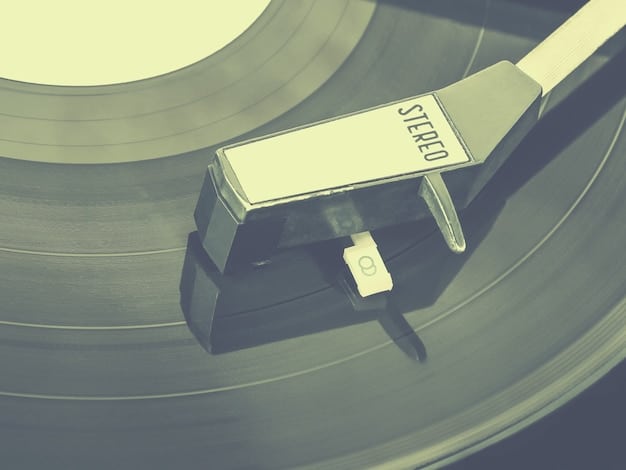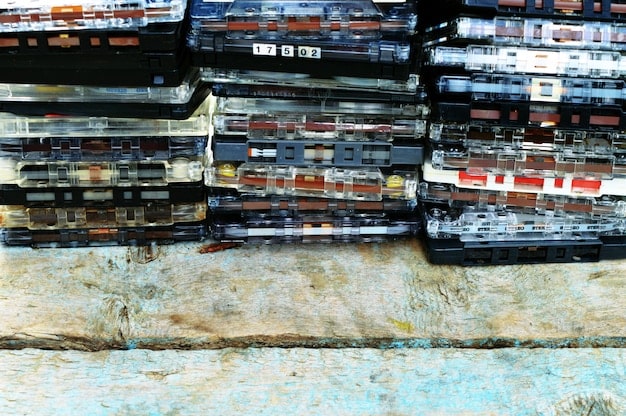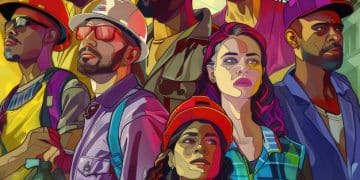From Vinyl to Streaming: Hip Hop’s Tech Transformation

The evolution of technology has profoundly reshaped how hip hop music is created, distributed, and consumed, fundamentally altering its cultural and economic landscape from the tactile experience of vinyl to the pervasive accessibility of streaming platforms.
The rhythm of hip hop isn’t just in its beats or rhymes; it’s also embedded in the technological shifts that have continually redefined its landscape. From dusty crates of vinyl to the infinite libraries of streaming, the journey of hip hop consumption reflects a dynamic interplay between artistic expression and technological innovation. This evolution has not only changed how we access music but has also profoundly influenced hip hop’s creative processes, cultural impact, and economic models. Let’s delve into this fascinating transformation to understand how technology has shaped the genre we know and love today.
The Vinyl Era: Foundations and Raw Authenticity
Hip hop’s roots are inextricably linked to the tactile and analog experience of vinyl. Before digital formats dominated, DJs were archeologists of sound, meticulously digging through record bins for breaks and samples. This era cultivated a unique culture around music discovery and live performance.
The vinyl record was more than just a medium for sound; it was the core instrument for early hip hop pioneers. DJs like Kool Herc, Grandmaster Flash, and Afrika Bambaataa revolutionized music by isolating drum breaks from funk, soul, and disco records, extending them, and looping them to create the foundational rhythms of hip hop. This practice of “break-beat DJing” was entirely dependent on the physical properties of vinyl records and the turntables that played them.
The Art of the Dig
Record digging became an essential ritual for producers and DJs. This involved sifting through countless albums in cluttered record stores, flea markets, and even friends’ collections to unearth obscure samples that could give their tracks a unique edge. This wasn’t merely about finding music; it was about discovery, about the hunt for sounds that nobody else had, creating a competitive yet collaborative environment within the nascent hip hop community.
- Curated Collections: Vinyl allowed for deep dives into genres, fostering a sense of connoisseurship among artists and fans.
- Physicality and Ownership: Owning a vinyl record meant possessing a tangible piece of art, complete with album art and liner notes.
- Live Performance Foundation: Turntables and vinyl were instrumental in developing DJing as a performance art.
The limitations of vinyl, such as its bulkiness and susceptibility to wear, inadvertently contributed to the ingenuity of early hip hop. Artists were forced to be resourceful, transforming existing sounds into something new through sampling and scratching. This era truly laid the groundwork for hip hop’s sonic identity.
The Album as an Artifact
In the vinyl era, an album was a complete artistic statement, often designed with elaborate cover art and detailed liner notes that provided context and credits. This enhanced the fan’s engagement with the music, offering a holistic experience beyond just listening.
The investment in buying a vinyl record also meant that listeners tended to engage more deeply with the music, listening to albums from start to finish. This fostered a different relationship between artist and audience, where the album was revered as a whole, not just a collection of individual tracks.
The Cassette and CD Revolutions: Portability and Accessibility
As hip hop gained traction, new formats emerged, offering greater portability and accessibility. The cassette tape and later the compact disc (CD) played pivotal roles in expanding hip hop’s reach beyond the confines of live venues and specialized record shops. These formats democratized access to music, making it easier for fans to carry, share, and consume hip hop on the go.
The cassette tape, in particular, was a game-changer. Its low cost and ease of duplication transformed it into the ultimate underground medium for hip hop. Mixtapes flourished, serving as a vital channel for aspiring MCs and DJs to share their work, break new artists, and build buzz without relying on major labels. These homemade compilations were a form of currency, traded among friends and fans, fostering a vibrant, grassroots culture.
Mixtapes and Bootlegs
- Grassroots Distribution: Mixtapes allowed artists to bypass traditional gatekeepers and directly reach their audience.
- DJ Showcases: DJs used mixtapes to display their scratching, blending, and track selection skills.
- New Artist Discovery: Many legendary hip hop artists gained their initial following through the mixtape circuit.
The advent of the CD brought superior sound quality and durability compared to cassettes. Its digital nature also paved the way for more precise sampling techniques in music production. While the CD offered a more polished listening experience, it began to shift the emphasis away from the raw, analog aesthetic of vinyl, introducing a new level of clarity and fidelity.

The CD also facilitated mass production and distribution, helping hip hop to become a global phenomenon. Albums were more readily available in mainstream retail outlets, broadening the genre’s appeal beyond its initial urban strongholds. This era saw hip hop artists selling millions of copies, cementing its status as a commercial powerhouse.
The Shift in Listening Habits
With cassettes and CDs, listening became more personal and mobile. Walkmans and portable CD players allowed fans to take their favorite tracks anywhere, from city streets to school halls. This increased immersion fostered deeper connections between fans and the music, truly integrating hip hop into daily life.
The ease of skipping tracks on a CD also subtly changed how albums were consumed. While vinyl encouraged listening from start to finish, CDs made it easier to jump to favored songs, potentially reducing the appreciation for an album as a cohesive body of work. This fragmentation, though minor at the time, foreshadowed future shifts in digital consumption.
The Digital Download Era: MP3s and Piracy’s Impact
The late 1990s and early 2000s ushered in the digital age, irrevocably altering the music industry. The rise of MP3s and peer-to-peer file-sharing platforms like Napster fundamentally challenged traditional models of music distribution and consumption. For hip hop, this era was a double-edged sword, offering unprecedented accessibility but also grappling with the rampant issue of piracy.
MP3s, with their compact file sizes, made it possible to share and download music rapidly over early internet connections. This instantly democratized access to music, allowing fans to obtain tracks they might never have found otherwise. Hip hop, often at the forefront of technological adoption, quickly embraced this new medium, leading to widespread sharing of tracks and albums.
Napster and Beyond
Napster, while controversial, was a pivotal moment. It demonstrated the immense demand for digital music and the potential for a frictionless distribution model. Although legally challenged, its impact was profound, forcing the music industry to rethink its strategies. For hip hop, which thrived on word-of-mouth and underground distribution, this informal network resonated deeply.
- Increased Access: Fans could easily find obscure tracks and artists, broadening their musical horizons.
- Challenges for Revenue: Piracy significantly eroded album sales, impacting artists’ incomes.
- Emergence of Digital Communities: Online forums and communities sprouted, dedicated to sharing and discussing hip hop.
The shift to digital downloads meant that physical formats became less critical. Album art and liner notes, once integral to the experience, diminished in importance as music became solely an audio file. This marked a significant departure from the tangible connection fans had with vinyl and CDs, moving towards a more abstract, data-driven relationship with music.
The Rise of Blogs and Online Forums
With digital music came the explosion of hip hop blogs and forums. These platforms became the new public squares where fans debated, discovered new music, and shared opinions. This decentralized ecosystem allowed for a diverse range of voices and perspectives to emerge, cultivating a more engaged and globally connected hip hop community. Artists also began using these platforms to directly engage with their fanbase.
While piracy posed a severe threat to the industry’s existing revenue streams, it also inadvertently fueled hip hop’s global expansion. Tracks shared illegally often introduced the genre to new audiences who might not have had access to it through traditional retail channels. This period was messy and disruptive, but it undeniably laid the groundwork for the digital consumption models we see today.
The Streaming Dominance: Spotify, Apple Music, and Beyond
The 2010s witnessed the ascent of streaming services, fundamentally reshaping the music industry landscape from one of ownership to one of access. Platforms like Spotify, Apple Music, and Pandora emerged as dominant forces, offering vast libraries of music on demand. For hip hop, streaming has been a transformative power, breaking down geographical barriers, accelerating discovery, and creating new pathways for artists to connect with global audiences.
Streaming’s primary appeal lies in its convenience and expansive catalogs. For a monthly subscription fee, listeners gain instant access to millions of tracks, eliminating the need for downloads or physical media. This “all-you-can-listen” model has driven an unprecedented surge in music consumption, making hip hop more accessible than ever before.
Algorithmic Curations and Playlists
A key feature of streaming platforms is their reliance on algorithms and curated playlists. These tools act as new gatekeepers and tastemakers, guiding listeners to new artists and tracks based on their listening habits. For hip hop, this means that emerging artists can gain significant exposure by being featured on popular playlists, potentially skyrocketing their careers overnight.
- Wider Reach: Artists can instantly reach a global audience without complex distribution networks.
- Accelerated Discovery: Algorithms introduce listeners to new music and artists they might not have found otherwise.
- New Revenue Streams: Royalties from streams, though small per play, accumulate significantly for popular artists.
The shift to streaming has also changed how music is produced and marketed. The emphasis is now often on creating “playlist-friendly” tracks that can easily fit into various curated collections. Singles often dominate over full albums, reflecting a change in listener habits towards individual songs rather than cohesive artistic statements. This has led to a race for virality, with artists often trying to create moments that will go viral on TikTok or other social media platforms, feeding directly back into streaming success.

The Global Reach of Hip Hop
Streaming has democratized hip hop’s global influence. Artists from diverse linguistic and cultural backgrounds can now reach international audiences with unprecedented ease. This has led to a vibrant cross-pollination of styles and sounds, making hip hop a truly global phenomenon, reflective of local identities alongside universal themes.
Furthermore, streaming data provides artists and labels with valuable insights into listener behavior. This data can inform touring decisions, marketing strategies, and even future creative directions, creating a feedback loop that continues to shape the genre. While concerns about artist compensation remain, streaming has undeniably opened new avenues for hip hop’s continued evolution and expansion.
Social Media and Short-Form Content: TikTok’s Influence
The intersection of streaming and social media, particularly short-form video platforms like TikTok, has created a new paradigm for hip hop’s cultural penetration. TikTok, with its emphasis on viral trends and user-generated content, has become a powerful launchpad for songs and artists, often dictating which tracks rise to prominence. This platform, alongside others like Instagram and YouTube, has blurred the lines between music consumption, social interaction, and content creation.
On TikTok, a snippet of a hip hop track can become a global sensation overnight, propelling both new and established artists into the mainstream. Users create dances, memes, and skits featuring these audio clips, turning songs into cultural phenomena. This organic, user-driven promotion is incredibly powerful, often leading directly to increased streams on dedicated music platforms.
The Rise of Micro-Content
This era signals a shift towards “micro-content,” where short, engaging audio-visual clips are often the primary point of discovery for a song. Artists now frequently consider how their music will perform on these platforms during the creation process, sometimes designing tracks with catchy, loopable sections specifically for virality.
- Viral Marketing: TikTok offers an unparalleled platform for tracks to go viral, reaching millions.
- Direct Artist-Fan Engagement: Artists can interact directly with fans, participating in trends and sharing behind-the-scenes content.
- New Creative Avenues: Challenges and trends inspire new dance moves and visual interpretations of music.
Beyond TikTok, platforms like Instagram and YouTube continue to be vital. Instagram Reels and YouTube Shorts operate similarly, leveraging short-form video to amplify music. Artists use these channels to release snippets, behind-the-scenes glimpses, and engage with fans, building communities around their music beyond traditional listening.
Direct Engagement and Brand Building
Social media empowers artists to manage their public image and interact directly with their fanbase, bypassing traditional media intermediaries. This direct connection fosters a stronger sense of community and loyalty among fans, making them feel more invested in an artist’s journey. It also opens up new avenues for brand partnerships and endorsements, further diversifying revenue streams.
However, this reliance on social media also brings its own challenges. The pressure to constantly create engaging content, maintain an active online presence, and adapt to rapidly changing trends can be demanding for artists. Yet, for hip hop, a genre built on innovation and direct connection, social media has proven to be a natural extension of its rebellious and pioneering spirit, continually redefining how its culture is consumed and shared globally.
The Future Landscape: AI, Web3, and Immersive Experiences
As we look to the horizon, technology continues to evolve at a relentless pace, promising even more profound transformations in how we consume hip hop. Artificial intelligence (AI), Web3 technologies like NFTs, and immersive experiences are poised to reshape not just distribution but also creation, ownership, and fan engagement. These emerging technologies hold the potential to democratize access further, empower artists, and offer fans unprecedented new ways to interact with their favorite music and culture.
AI’s role in music is rapidly expanding, from assisting in beat production and songwriting through generative algorithms to personalizing listening experiences with hyper-specific recommendations. While some express concerns about AI’s potential to dilute artistic authenticity, it also offers powerful tools for artists to innovate and experiment with new sounds and structures. Imagine AI-powered mastering on demand, or algorithms that help uncover obscure samples from vast digital archives with incredible efficiency. This could lower the barrier to entry for aspiring producers.
Web3, NFTs, and Artist Ownership
Web3 technologies, particularly Non-Fungible Tokens (NFTs), present a groundbreaking shift in the concept of digital ownership and artist compensation. NFTs allow artists to tokenize their music, artwork, or unique fan experiences, selling them directly to their audience. This model could bypass traditional intermediaries, giving artists greater control over their intellectual property and a larger share of the revenue.
- Decentralized Distribution: NFTs offer new models for artists to distribute music and generate revenue.
- Enhanced Fan Engagement: Unique digital collectibles and fan-artist interactions can be tokenized.
- New Creative Tools: AI and VR/AR could foster entirely new forms of musical and visual expression.
For hip hop, which has always valued independence and entrepreneurship, Web3 offers exciting possibilities. Artists could create exclusive fan communities, offer tiered access to unreleased music, or even share ownership of future royalties with their most dedicated supporters through tokenized mechanisms. This could foster a new era of direct artist-to-fan economies.
Immersive Audio and Virtual Worlds
Beyond ownership, immersive technologies like virtual reality (VR) and augmented reality (AR) are set to transform the listening experience. Imagine attending a virtual hip hop concert in the metaverse, where you can interact with other fans and experience the performance in a truly spatial and dynamic way. Or AR apps that allow you to remix tracks in real-time as you walk through your city, blending music with your physical environment.
These technologies promise to blur the lines between listening and active participation, offering multi-sensory experiences that go far beyond traditional playback. While the full impact of these innovations is yet to be realized, the historical trajectory of hip hop shows a consistent openness to embracing new technologies. From vinyl to streaming, and now into the realm of AI and Web3, technology continues to be not just a conduit for hip hop but an intrinsic part of its ever-evolving identity.
The future of hip hop consumption promises to be more personalized, interactive, and decentralized, giving both artists and fans unprecedented power and creative freedom as the genre continues to innovate and resonate across the globe.
| Key Transformation | Brief Description |
|---|---|
| 💿 Vinyl Era | Foundation of DJing, extensive “digging,” and physical ownership. |
| cassettes/CDs | Increased portability, democratized access via mixtapes, and improved sound quality. |
| 💻 Digital Downloads | MP3s and peer-to-peer sharing led to widespread accessibility but also piracy challenges. |
| 📱 Streaming & Social Media | Dominant consumption, algorithmic discovery, global reach, and viral content via platforms like TikTok. |
Frequently Asked Questions
▼
Vinyl records were fundamental for early hip hop, enabling DJs to isolate and loop “break-beats” from existing tracks. This technique, known as break-beat DJing, directly led to the development of sampling and scratching, foundational elements of hip hop production. The materiality of vinyl fostered a culture of “digging” for obscure sounds, giving early hip hop its unique sonic identity and creative spirit.
▼
Mixtapes, primarily on cassette tape, were crucial for hip hop’s grassroots expansion. They served as an informal distribution network, allowing artists and DJs to share their music, showcase skills, and build a following without relying on major record labels. Mixtapes fostered a vibrant underground culture, helping new artists gain recognition and disseminate hip hop to wider audiences, often ahead of commercial releases.
▼
The digital download era, spearheaded by MP3s and platforms like Napster, dramatically increased hip hop’s accessibility, making it easier for fans to discover and share music. While it expanded the genre’s global reach, rampant piracy also significantly impacted album sales and traditional revenue streams for artists and labels, forcing the industry to adapt and eventually pivot towards streaming models.
▼
Streaming platforms like Spotify and Apple Music have become the dominant mode of hip hop consumption, offering vast libraries on demand. Their main impact includes accelerating global discovery through algorithmic curation and playlists, providing new revenue streams, and enabling artists to reach wider audiences with unprecedented ease. It has shifted focus from album ownership to track access, influencing production methods toward “playlist-friendly” songs.
▼
TikTok has become a significant driver of hip hop’s virality and cultural trends. Short audio snippets of hip hop tracks often go viral through user-generated content, leading to massive spikes in streams and propelling artists into the mainstream. This platform emphasizes “micro-content” and direct artist-fan engagement, profoundly influencing how new music is discovered, marketed, and consumed by a global, often younger, audience.
Conclusion
From the tangible grooves of a vinyl record to the ephemeral streams of digital platforms, the journey of hip hop consumption is a testament to its adaptive nature and capacity for reinvention. Each technological shift—be it the portability of cassettes, the accessibility of MP3s, or the global reach of streaming and social media—has not only altered how we listen but also fundamentally reshaped hip hop’s artistic forms, cultural impact, and economic landscape. As AI and Web3 emerge, the genre continues its dynamic evolution, promising even more innovative ways for artists to create and connect, and for fans to engage with the vibrant, ever-expanding world of hip hop culture.





